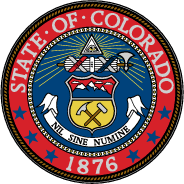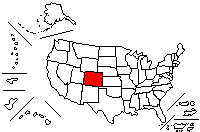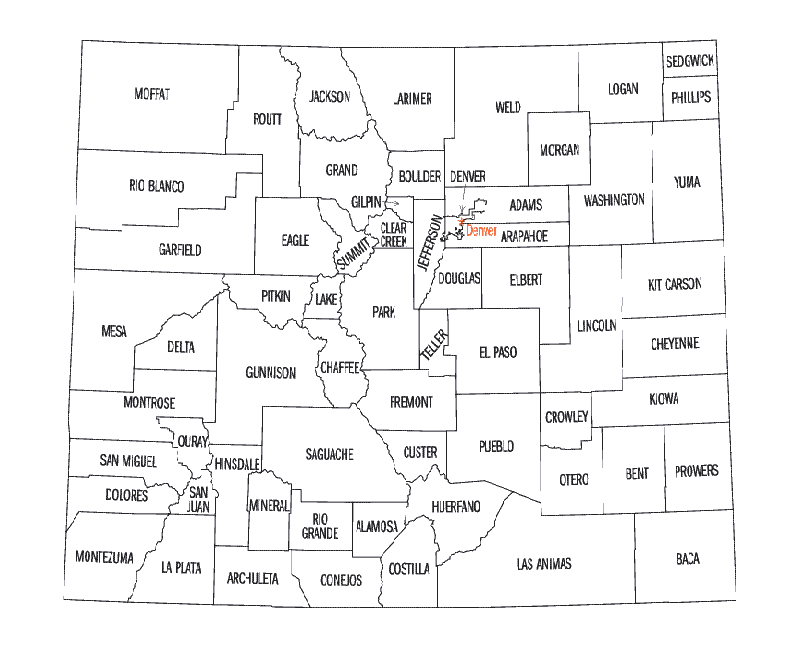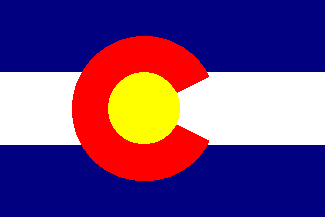
 |
|

















Where the Columbines Grow |
Donde los Colombinos Crecen
Donde los nevados coro
El bisonte se ha coro
Dejen que la violeta coro
Esta es la tierra |


Flag:
The colors used in the state's flag are symbolic of certain geographical features of the state. The gold stands for the abundant sunshine that Colorado enjoys. The white symbolizes our snowcapped mountains. The blue stands for the clear blue skies in Colorado while the red represents the ruddy color of much of our state's earth.
Bandera:
Los colores son simbolicos de ciertas característocas del estado. El dorado
significa la abundancia de brillo del sol que disfruta Colorado. El blanco
simboliza las montañas con nieves. El azul simboliza por los cielos azuldes
de Colorado mientras el rojo representa el color de la tierra del estado.
The flag consists of three alternate stripes of equal width
and at right angles to the staff, the two outer stripes to be
blue of the same color as in the blue field of the national
flag and the middle stripe to be white.
In the flag there is a circular red C, of the same color as the
red in the national flag of the United States. The diameter of the
letter is two-thirds of the width of the flag. The inner line of
the opening of the letter C is three-fourths of the width of its
body or bar, and the outer line of the opening is double the length
of the inner line thereof. Completely filling the open space inside
the letter C is a golden disk, The state flag was adopted on June 5, 1911
by an act of the General
Assembly. The flag was adopted to be used on all occasions when the
state is officially and publicly represented, with the privilege of
use by all citizens upon such occasions as they deem fitting and
appropriate. Laws pertaining to use of the National flag are also
applicable to use of the State flag.
The flag was originally designed by Andrew Carlisle Johnson in 1911.
Precise colors of red and blue were not designated in the 1911
legislation and some controversy arose over these colors.
On February 28, 1929, the General Assembly stipulated the precise
colors of red and blue as the same as the national flag. Controversy
also arose over the size of the letter C and on March 31, 1964,
the General Assembly further modified the 1911 legislation by
revising the distance from the staff for the letter C and its
diameter.
La bandera consiste de tres rayas de igual tamaño, las dos rayas a los extremos
será azul del mismo color azul de la bandera nacional y la raya del medio será en blanco.
En la bandera hay una C circular en rojo, el mismo rojo de la bandera nacional de los
Estados Unidos. El diametro de la letra es dos tercios del ancho de la bandra. En la linea
interior de la letra C es una cuarta parte del ancho de la letra c y es un disco dorado.
La bandera estatal fuú adoptada el 5 de junio de 1911 por una asamblea general.
La bandera fué adaptado para ser usado en todas las ocaciones dode el estado estubiera representado
tanto oficialmente como publicamente, con el privilegio de ser usado por todo ciudadano
en las ocaciones que ellos consideren correcto y apropiado. La leyes sobre el uso de la
bandera Nacional será aplicables al uso de la bandera Estatal.
La bandera fué originamente diseñado por Andrew Carlisle Johnson en 1911.
Los colores precisos de rojo y azul no fueron desinado in la legislación de 1911
y se crearon ciertas controversias por esos colores.
En 28 de febrero de 1929, la Asamblea General estipuló que los colores correctos del
rojo y azul serían los mismos colores de la bandera Nacional. La controversia surgió también
por el tamaño de la letra C el 31 de marzo de 1964, y la Asamblea General modificó la legislación
de 1911 revisando el diametro de la C y es como se usa ahora.

Colorado
Capital City: Denver
Admission to Statehood: August 1, 1876
Motto: Nil sine Numine -
Nothing without Providence
This motto is credited to William Gilpin, first territorial
governor of Colorado. It may actually be an adaptation of a line from Virgil’s Aeneid.
National: Coloradoans
Nicknames: Centennial State / Colorful Colorado
Origin of state's name: named by Spanish. Taken from the Spanish for the "color red" and was applied
to the Colorado river.
Colorado (se pronuncia Co-lo-rá-dou en inglés)(Co-lo-rá-do en español)
Ciudad Capital: Denver (se pronuncia Dén-ver en inglés y español)
Admisión como estado: 1 de agosto de 1876
Lema: Nil sine Numine - Nada sin la Providencia
Este lema es acreditado a William Gilpin,
primer governador territorial de Colorado. Puede ser una adaptación de una linea de la
Eneida de Virgilio.
Gentilicio: Coloradense
Cognomento: Estado Centenario / Pintoresco Corado
Origen del nombre del estado: Nombre dado por los españoles. Tomado del Español para el color rojo y fué aplicado
al Río Colorado


As documented in the State of Colorado archives, the circular Seal of the State
of Colorado is an adaptation of the Territorial Seal which was adopted by the First
Territorial Assembly on November 6, 1861. The only changes made in the Territorial
Seal design being the substitution of the words, "State of Colorado" and the figures
"1876" for the corresponding inscriptions on the territorial seal. The first General
Assembly of the State of Colorado approved the adoption of the state seal on March 15,
1877.
By statute, the seal of the State is two and one-half inches in diameter with the following
devices inscribed thereon: At the top is the eye of God within a trangle, from which golden
rays radiate on two sides. Below the eye is a scroll, the Roman fasces, a bundle of birch or
elm rods with a battle axe bound together by red thongs and bearing on a band of red, white
and blue, the word, "Union and Constitution." The Roman fasces is the insignia of a republican
form of government. The bundle of rods bound together symbolizes strength which is lacking in
the single rod. The axe symbolizes authority and leadership.
Below the scroll is the heraldic
shield bearing across the top on a red ground three snow-capped mountains with clouds above
them. The lower half of the shield has two miner's tools, the pick and sledge hammer,
crossed on a golden ground. Below the shield in a semicircle is the motto, "Nil Sine Numine",
Latin words meaning "nothing without the Deity", and at the bottom the figures 1876,
the year Colorado came into statehood.
The design for the Territorial Seal which served as a model for the State Seal or Great
Seal of Colorado has been variously credited, but the individual primarily responsible was
Lewis Ledyard Weld, the Territorial Secretary, appointed by President Lincoln in July of 1861.
There is also evidence that Territorial Governor William Gilpin also was at least partially
responsible for the design. Both Weld and Gilpin were knowledgable in the art and symbolism
of heraldry. Elements of design from both the Weld and Gilpin family coat-of-arms are
incorporated in the Territorial Seal.
The circular Seal of the State of Colorado is an adaptation of the Territorial Seal which
was adopted by the First Territorial Assembly on November 6, 1861. The only changes made
in the Territorial Seal design being the substitution of the words, "State of Colorado"
and the figures "1876" for the corresponding inscriptions on the territorial seal. The
first General Assembly of the State of Colorado approved the adoption of the state seal
on March 15, 1877. The Colorado Secretary of State alone is authorized to affix the Great
Seal of Colorado to any document whatsoever.
By statute, the seal of the State is two and one-half inches in diameter with
the following devices inscribed thereon: At the top is the eye of God within a
trangle, from which golden rays radiate on two sides. Below the eye is a scroll,
the Roman fasces, a bundle of birch or elm rods with a battle axe bound together by
red thongs and bearing on a band of red, white and blue, the word, "Union and Constitution."
The Roman fasces is the insignia of a republican form of government. The bundle of rods bound
together symbolizes strength which is lacking in the single rod. The axe symbolizes authority
and leadership.
Below the scroll is the heraldic shield bearing across the top on a red ground
three snow-capped mountains with clouds above them. The lower half of the shield has
two miner's tools, the pick and sledge hammer, crossed on a golden ground. Below the shield
in a semicircle is the motto, "Nil Sine Numine", Latin words meaning "nothing without the
Deity", and at the bottom the figures 1876, the year Colorado came into statehood.
Como está documentado en los archivos del Estado de Colorado, el Sello Circular
del Estado de Colorado is una adaptación del sello territorial la cuál
fué adoptada por la Primera Asamblea Territorial el 6 de noviembre de 1861. El
único cambio hecho en el sello fué el substituir la palabras, "State Of Colorado" (Estado de Coloraro)
y el año 1876 como correspondientes inscripciones en el sello territorial. La primera Asamblea General
del Estado de Colorado aprovó la adopción del sello estatal el 15 de marzo
de 1877.
Por estatuto, el sello del estado es dos y media pulgadas de diametro con la
siguiente inscripciones: en el top esta el ojo de Dios dentro de un triangulo,
desde el cual rayos dorados iluminan hacia dos lados. De bajo de
ojo hay un pergamino, en forma romana,
un fardo de varas de abedul u olmo con un acha de batalla unidos
por tiras
rojas y orientado hacia la banda en rojo, blanco y azul, La palabra
"Union and Constitution" (Unión y Constitución). Los rollos romamos is la isnsignia de
una forma republicana de gobierno. El fajo de varas unidas simboliza la
fuerza si faltara una sola vara. El acha simboliza la autoridad y el
liderasgo.
Bajo el pergamino está el escudo heraldico, en el campo rojo hay tres montañas con su picos cubierto de nieve
y nueves sobre ellos. La mitad de abajo tiene dos herramientas de minería,
el pico y martillo, crusados en un fondo dorado. Bajo el escudo en un semicirculo
está el lema,"Nil Sine Numine", palabras latinas que significan "Nada
sin Dios", y abajo el año 1876, el año en que Colorado entró a ser
parte de los Estados Unidos.

History
Colorado is in the Rocky Mountain west of the United States
and is the highest state in the union, averaging in elevation
2070 m (6790 ft) above sea level. It has 53 peaks of more than
4,268 m (14,000 ft) and over 250 peaks higher than 3,963 m (13,000 ft).
Colorado is bordered by Nebraska on the northeast, Kansas on the east,
Oklahoma on the southeast, New Mexico on the south, Utah on the west,
and Wyoming on the north. The name Colorado is derived from the
Spanish word meaning "colored" or "reddish" and describes many of
the colorful rock formations that can be seen in the mountains and
the western plateaus
of the state
Artifact evidence from various locations around Colorado indicates
that nomadic hunters roamed the area at least 10,000 years ago.
This evidence includes many examples of Folsom age projectile points
that are very distinctive in design. People known as the Basket
Makers inhabited the plateaus of the southwestern part of the state
by the 1st century AD. This culture eventually merged with the
"ancient ones," or Anasazi, by the year AD800. The Anasazi became
what are now called the cliff dwellers of the mesa country,
probably in response to threats from nomadic tribes of the region.
Between AD 1000 and 1300, magnificent stone dwellings were developed
into entire cities that clung precipitously to the cliff walls of
the deep canyons. By 1300 this culture had disappeared for unknown
reasons. When European exploration began, Native American culture
was dominated by wandering tribes such as the Ute, Cheyenne, and
Arapaho.
Exploration and Acquisition by the United States
The earliest European explorers were the Spaniards. Francisco Coronado
probably came north into the San Luis Valley (1541). The goal,
never attained, of these conquistadors was to find the Seven Cities
of Cibola, with their vast stores of gold and silver.
The main material impact of the Spaniards was the introduction of
the horse to the region.
With the Louisiana Purchase (1803), the United States, under
President Thomas Jefferson, obtained from France the northern and
eastern parts of Colorado. Almost immediately exploration by the
United States began. Zebulon Montgomery Pike led a party into Colorado
in 1806. Other explorations and surveys of the region followed,
led by Stephen H. Long (1820), John C. Fremont (1842-43, 1845),
and Ferdinand V. Hayden (1873-75). The area's first semipermanent
white inhabitants were the mountain men, who were trappers and fur
traders.
The southern and western parts of Colorado were acquired by the
United States under the Treaty of Guadalupe Hidalgo (1848) at
the conclusion of the Mexican War. A decade later, gold was
discovered in Cherry Creek near Denver, and the region's population
exploded nearly overnight. Not only did miners come to Colorado,
but the "Great American Desert," so described by Stephen Long,
attracted ranchers and farmers to help feed the mining boom.
Ignoring Indian claims to the area, the settlers proclaimed it the
Territory of Jefferson, a move not recognized by the U.S. Congress.
Colorado became an official United States territory in 1861.
Statehood
By the time Colorado became a state in 1876, the early gold-mining
boom was over, and the economy was being built upon silver. From
the early 1870s until the single gold standard was established in
1893, silver was king. That single act of Congress crippled the
ilver industry and sank Colorado into a deep depression. The gold
discovery in Cripple Creek the next year, however, helped revive
the economy.
With the signing of a treaty with the Ute chief Ouray in 1880,
the Indian wars (with the Arapaho, Cheyenne, and later the Ute)
ended. In 1881 the Ute were removed to a reservation in Utah.
The Territory of Jefferson, an unrecognized U.S. territory
corresponding roughly to present Colorado, was established
following the discovery (1858) of gold there. On Aug. 1,
1859, the settlers met in convention to consider separation
from the Kansas Territory, of which the area was then part.
The U.S. Congress, hamstrung by the slavery controversy,
refused to consider a partition for territorial status,
but the convention went ahead and adopted a constitution
for the Jefferson Territory on October 24. The illegal
government was unable to exert authority, however, and
it was superseded in February 1861 when Congress formed
the Territory of Colorado.
Historia
Colorado está en las Rocallosas al oeste de los Estados Unidos y es
el estado más alto de la unión, haciendo un promedio en la
elevación de 2070 m (6790 pies) sobre nivel del mar. Tiene 53 picos
de más de 4.268 m (14.000 pies) y sobre 250 picos más arriba de
3.963 m (13.000 pies). Colorado está rodeado por Nebraska en el
noreste, Kansas en el este, Oklahoma en el sureste, Nuevo México
en el sur, Utah en el oeste, y Wyoming en el norte. El nombre
Colorado se deriva del significado español de la palabra " coloreado
" o " rojizo " y describe muchas de las formaciones de roca coloridas
que se pueden considerar en las montañas y las mesetas occidentales
del estado.
La evidencia de artículos de varias localizaciones alrededor de
Colorado indica que los cazadores nómadas vagaron el área por lo
menos hace 10.000 años. Esta evidencia incluye muchos ejemplos de
los puntos del proyectil de la edad de Folsom que son muy distintivos
en diseño. La gente conocida como los fabricantes de la cesta
habitó las mesetas de la parte al sudoeste del estado al lado del
del primer siglo. Esta cultura se combinó eventual con " las
antiguos, " o Anasazi, por el año 800. El Anasazi se convirtió en
qué ahora se llaman los habitantes del acantilado del país del mesa,
probablemente en respuesta a amenazas de las tribus nómadas de la
región. Entre el 1000 y 1300, las viviendas de piedra
magníficas fueron desarrolladas en las ciudades enteras que se
aferraron empinado en las paredes del acantilado de las barrancas
profundas. Por 1300 esta cultura había desaparecido por razones
desconocidas. Cuando la exploración europea comenzó, la cultura
americana nativa fue dominada por las tribus que vagaban tales como el
Ute, la Cheyenne, y el Arapaho. La exploración y la adquisición por
los Estados Unidos los primeros exploradores europeos eran los
españoles. Francisco Coronado vino probablemente al norte en el
valle del San Luis (1541). La meta, nunca lograda, de estos
conquistadors era encontrar las siete ciudades de Cibola, con sus
almacenes extensos del oro y de la plata. El impacto material
principal de los españoles era la introducción del caballo a la
región. Con la compra de Luisiana (1803), los Estados Unidos, bajo
de presidente Thomas Jefferson, obtuvieron de Francia las partes
norteñas y del este de Colorado. La exploración por los Estados
Unidos comenzó casi inmediatamente. Zebulon Montgomery Pikw
condujo un partido en Colorado en 1806. Otras exploraciones y
exámenes de la región siguieron, conducido por Stephen H. Long
(1820), John C. Fremont (1842-43, 1845), y Ferdinand V. Hayden
(1873-75). Los primeros habitantes blancos semipermanentes del área
eran los hombres de la montaña, que eran tramperos y comerciantes de
la piel. Las partes meridionales y occidentales de Colorado fueron
adquiridas por los Estados Unidos bajo tratado de Guadalupe Hidalgo
(1848) en la conclusión de la guerra mexicana. Una década más
adelante, el oro fue descubierto en el cala de la cereza cerca de
Denver, y la población de la región aumentó casi durante la noche.
Los mineros vinieron no sólo a Colorado, sino que el " gran
desierto americano, " así que descrito por Stephen Long, rancheros
y granjeros atraidos por el auge de la minería. Ignorando el reclamo
del indio al área, los colonos la proclamaron el
territorio de Jefferson, un movimiento no reconocido por el congreso
de ESTADOS UNIDOS. Colorado se convirtió en un territorio oficial de
Estados Unidos en 1861. Statehood para el momento en que Colorado se
convirtió en un estado en 1876, el auge temprano de la minería
aurífera encima, y la economía era construida sobre la plata. A principios
1870s hasta el 1893 en que la economía a base del oro fue establecido,
la plata era la base importante.
Esa Acta Única del congreso lisió la industria
de la plata y hundió Colorado en una depresión profunda. El
descubrimiento del oro en el Cripple Creek el año próximo, sin
embargo, ayudó para restablecer la economía. Con la firma de un
tratado con el jefe principal de la tribu ute, Ute, en 1880,
las guerras indias (con el
Arapaho, Cheyenne, y más adelante el Ute) terminadas. En 1881 el Ute
fue enviado a una reservación en Utah.
El territorio de Jefferson, un territorio no reconozido de ESTADOS
UNIDOS que correspondía áspero a actual Colorado, fue establecido
después del descubrimiento (1858) del oro allí. De agosto el 1 de
1859, los colonos satisficieron en la convención para considerar la
separación del territorio de Kansas, de el cual el área era entonces
parte. El congreso de ESTADOS UNIDOS, paralizado por la controversia
de la esclavitud, rechazada para considerar a una partición para el
estado territorial, pero a la convención fue a continuación y
adoptó una constitución para el territorio de Jefferson de octubre
el 24. El gobierno ilegal no podía ejercer autoridad, sin embargo, y
fue reemplazado en febrero de 1861 en que el congreso formó el
territorio de Colorado.
